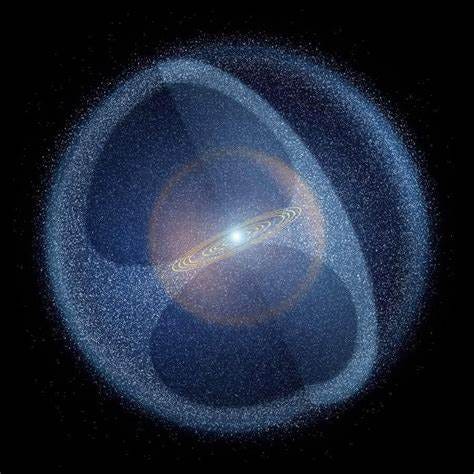Exploring the Oort Cloud: Significance and Future Prospects
Written on
Chapter 1: Understanding the Oort Cloud
The Oort Cloud represents a theoretical zone located at the outermost part of our solar system. This region is postulated to contain a vast, spherical accumulation of icy celestial bodies, stretching roughly from 2,000 astronomical units (AU) to as far as 100,000 AU from the Sun. It is widely believed that this extensive cloud serves as the origin for long-period comets, which have orbital periods exceeding 200 years and emerge from the farthest reaches of the solar system.
Dutch astronomer Jan Oort first introduced the concept of the Oort Cloud in 1950. He observed that comets seemed to originate from various directions in the sky, rather than being confined to a singular plane. This led him to hypothesize the existence of a substantial reservoir of comets in the outer solar system, now known as the Oort Cloud.
Although the Oort Cloud has never been directly observed, scientists have inferred its presence through the study of cometary orbits and other distant objects in our solar system. Recent years have seen an increase in interest surrounding the exploration of this enigmatic region, driven by the quest to understand the origins of our solar system and the potential resources it may hold for future space missions.
One primary objective of studying the Oort Cloud is to examine the comets that stem from this area. These comets are considered remnants from the solar system's formation, and analyzing them can yield valuable insights into the conditions and processes that shaped our planet and others.
Comets are also believed to harbor a variety of organic compounds, including amino acids, which are essential for life. By investigating these celestial bodies from the Oort Cloud, researchers hope to deepen their understanding of life's origins on Earth and the prospects for extraterrestrial life within our solar system.
Beyond its scientific importance, the Oort Cloud holds potential commercial value. The icy materials found in this region are thought to be rich in water and other volatiles, which could be harnessed as resources for future space exploration and colonization.
Water, in particular, is a precious commodity in space travel, as it can be utilized for producing breathable oxygen and hydrogen fuel. Additionally, through electrolysis, water can be split into its elemental gases, creating useful resources for astronauts.
To explore the Oort Cloud effectively, scientists will need to innovate new technologies and spacecraft capable of enduring the extreme conditions of deep space. One possibility is to develop nuclear-powered spacecraft, which could provide the necessary thrust and energy to reach the outer solar system.
Alternatively, gravitational assists from other planets could be employed to propel spacecraft toward the Oort Cloud. This technique has been successfully used in prior missions to explore various parts of our solar system.
One notable mission in development is the Comet Interceptor, spearheaded by the European Space Agency (ESA). This mission aims to send a spacecraft to remain in a holding position near Earth, ready to intercept a newly identified comet from the Oort Cloud.
The spacecraft will be equipped with an array of instruments, including cameras, spectrometers, and dust analyzers, to closely study the comet's composition, structure, and history. Such data could illuminate the origins of our solar system and the conditions conducive to planet formation.
Another ambitious mission under consideration is the Oort Cloud Express, which would involve dispatching a spacecraft to traverse the Oort Cloud for a detailed examination of its makeup and structure. Advanced propulsion technologies, such as nuclear propulsion or solar sails, would be necessary for this journey.
In addition to these proposed missions, ongoing efforts are being made to search for and analyze comets originating from the Oort Cloud using both ground-based telescopes and spaceborne observatories. For instance, NASA's NEOWISE mission is actively surveying the sky for comets and near-Earth objects, while the ESA's Rosetta mission investigated comet 67P/Churyumov-Gerasimenko, believed to have originated from the Oort Cloud.
Despite the promising prospects of Oort Cloud exploration, significant challenges and risks remain. The immense distances involved necessitate cutting-edge propulsion technologies and sophisticated spacecraft designs.
Moreover, the Oort Cloud is thought to contain numerous comets and icy bodies, which could pose hazards to spacecraft due to their high velocities and potential collision risks.
Ethical considerations also arise when contemplating the exploration of the Oort Cloud. This region is believed to house many pristine objects that have remained unchanged since the early solar system's formation. Some scientists argue against disturbing these objects, as they serve as a unique record of our solar system's history.
Nonetheless, the exploration of the Oort Cloud offers substantial scientific and commercial opportunities. By studying the comets originating from this region, we can glean important insights into the origins of our solar system and the potential for life beyond our planet.
Furthermore, the resources contained within the Oort Cloud could significantly aid future space exploration and colonization initiatives. By advancing technologies and spacecraft designed for deep space missions, we can unlock the secrets of the Oort Cloud and usher in a new era of exploration and discovery.

Chapter 2: The Future of Oort Cloud Exploration
In light of the growing interest in the Oort Cloud, various missions and studies are underway.
The video "Unveiling the Oort Cloud" provides insights into this mysterious region and its significance in understanding our solar system.
"The Oort Cloud: Crash Course Astronomy #22" discusses the theoretical aspects of the Oort Cloud and its role in the formation of comets.